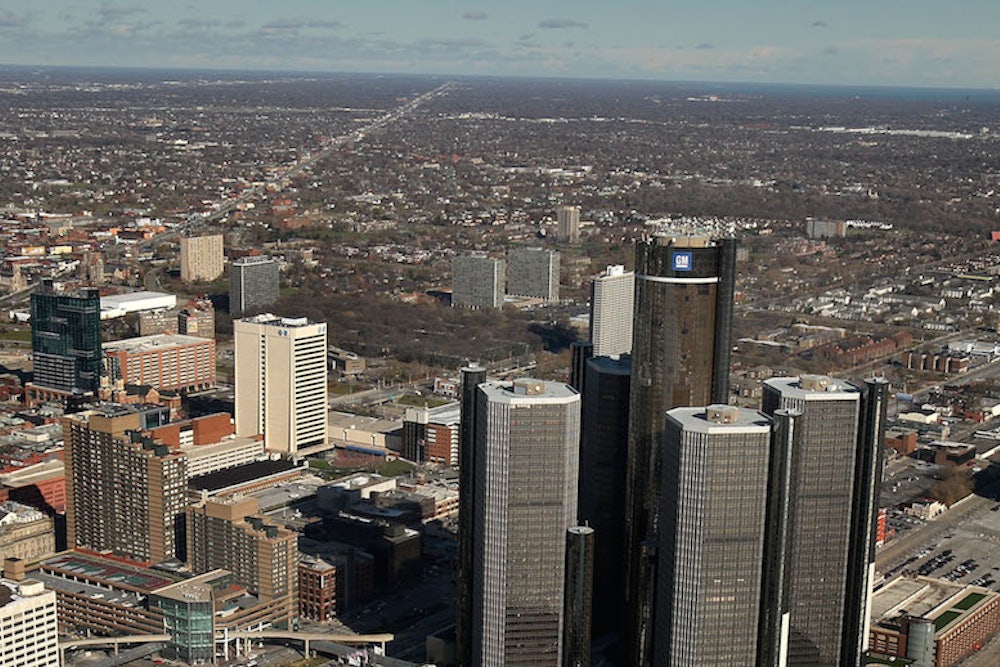Just 15 months after filing for bankruptcy, Detroit moved one step closer to financial solvency Friday when a judge approved the city’s exit plan to drop $7 billion in debt. “Detroit has a bright future now,” said Michigan Governor Rick Snyder. It's still too early, however, to call this a comeback. In order for this exit plan to work, Detroit is still going to have to solve one of its biggest problems: attracting new residents rather than driving them away.
The exit plan falls on the “skinny end of feasibility,” court-appointed expert Martha Kopacz testified in October. The city will need to develop a steady revenue stream to meet its obligations. Fewer than 700,000 people live in Detroit after decades of white flight into the surrounding suburbs. They are mostly poor, with 38 percent living below the poverty level. Last year, half of Detroit’s property owners were unable to pay their taxes, which are the highest in the state for cities with a population over 50,000. The combination of high taxes and poor residents puts the city and its residents in a lose-lose cycle. “Part of the goal of the exit is making Detroit attractive to people who are not poor, who can pay taxes,” says Wayne State University bankruptcy law professor Laura Bartell.
But making the city a desirable place to live is going to take a lot of money—maybe even more than the approximately $1.7 billion set aside in the plan. It’s no secret that Detroit is a difficult place to live. The bankruptcy trial put the inner workings of the city in the harsh spotlight, methodically detailing all of the ways the Detroit no longer works for its residents. A 2013 report by Emergency Manager Kevyn Orr found that 15 percent of all “parcels” of land in the city were vacant, and 38,000 vacant structures were in potentially dangerous condition. Response times for highest priority crimes took an average of 58 minutes. Around 40 percent of streetlights were out. All of these problems will have to improve for Michiganders to start looking at Detroit as a reasonable place to open a business or raise a family, Bartell said.
Still, the city is trying to spruce up. Developers like Quicken Loans founder Dan Gilbert have swooped to the downtown and midtown areas, buying up armloads of cheap properties. Other big corporations like Blue Cross Blue Shield of Michigan and Fifth Third Bank Eastern Michigan have moved from the suburbs to downtown Detroit as well, bringing with them employees who open their wallets to nearby businesses. But for now, it’s a renaissance that’s mostly localized to the city’s core, leaving most of Detroit’s 139 square miles still impoverished and blighted.
Compared to other cities that have recently gone bankrupt, Detroit is lucky. Vallejo, California, which exited bankruptcy in 2011, is teetering on the brink of financial collapse again. The city made projections about its expected costs and revenues, especially its pensions obligations, that ended up being wrong, says California layer Michael Sweet. Even after exiting bankruptcy, the slice of the city’s budget dedicated to pension payments continued increasing. Detroit, unlike Vallejo, made cuts to its pension obligations—a decision that will inevitably hurt city pensioners, but will likely protect Detroit from falling into Vallejo’s pension death trap. “Pensions won’t be the thing to push Detroit back,” Bartell said.
The pensioners’ suffering was partially mitigated by a “Grand Bargain” that was forged this summer. Over a period of 20 years, about $816 million from the Detroit Institute of Arts, Michigan state government and a handful of foundations will replace the money that would have come from deeper cuts to pensions or from selling off the DIA's collection (the DIA was instead spun off to the safety of a non-profit trust). Detroit’s status as the biggest city in the country to go bankrupt might have made it a national embarrassment, but it also came with the perks of an art museum and deep-pocketed supporters. “The stars aligned – no other city will be like Detroit,” Sweet said.
Now, the city embarks on a recovery path with many potential pitfalls, including failure to improve city services, a national economic downturn, or elections that install less competent city leaders. (Former Mayor Kwame Kilpatrick’s prosecutors said that the corrupt dealings that landed him in prison are also partially to blame for the city’s bankruptcy.) Detroit will rely on all of its stakeholders—the state and city government, the business community, foundations, and its current and future residents—continuing to rally around healing the city, even after the fanfare of bankruptcy fades.
